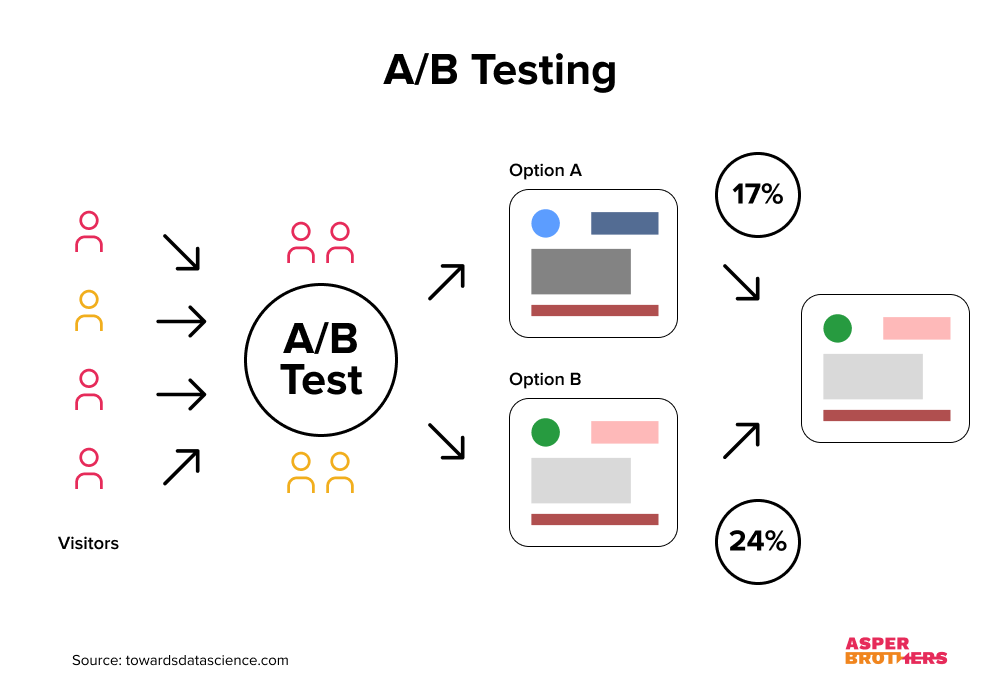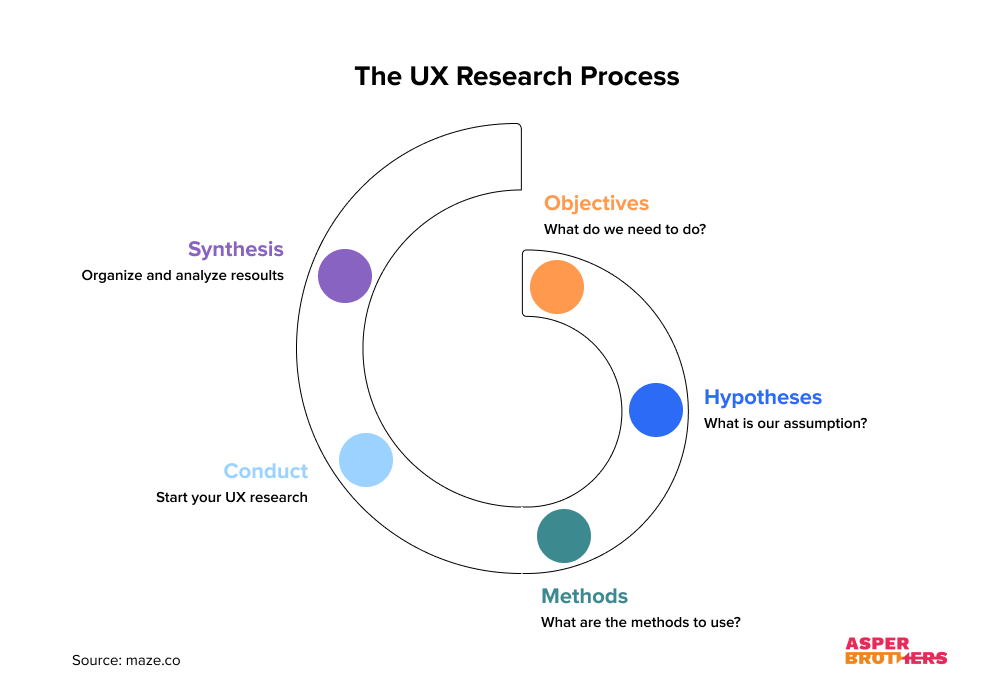UX Deliverables - How User Experience Analysis Support the Software Development Process
The UX design is the process design teams use to create products that provide important and consistent experiences to users, and...

This article describes the fundamentals of UX research, its importance, popular UX research techniques, and the qualities of a good UX researcher.
UX research uses different user research and feedback methodologies to gather valuable insights into the end user’s perspective of the product. UX research provides developers and designers with a clear view of what customers need from them, how they behave under certain conditions, and what they should avoid.
UX Research aims to develop a user-centered product by helping the product teams make informed design decisions.
UX research mainly consists of two things. Data collection and data synthesis for usability enhancements. UX Researchers use different quantitative and qualitative research techniques from other fields, such as academia, market research, scientific research, and some unique methods from the UX world.
The initial phase starts by understanding the project and customer requirements. Researchers will conduct surveys, interviews, literature reviews, etc. Iteratively improve the design based on the gathered insights.

There are many methods and types of UX research. An experienced team will select the right forms to get the most useful results.
A product built without UX research has a risk of failing anytime because it is difficult to meet up-to-date user expectations. According to research, 70% of online businesses that fail do so because of bad usability. Therefore, a significant amount of time and money can be wasted without incorporating UX research into any product.
UX research is a continuous procedure where data gathering and deriving insights happen throughout the product development process. When enhancing existing products or creating new ones, these research insights are imperative to make an informed product design process and marketing decisions. Insights from the end-users help businesses launch user-centered and intuitive products to the market. Nowadays, companies invest in UX research due to their competitive advantage and high ROI.
Forbes says that every dollar invested in UX brings $100 in return. This is an average figure, but it’s an ROI of an impressive 9,900%.
Now that we understand the fundamental concepts of user experience research, let’s next move on to identifying the seven most famous UX research methods used for user research around the globe.
Interviewing is one of the quickest and easiest methods of conducting user research about an existing product. Researchers can conduct one-on-one user interviews or focus groups with more than one user involved. You can use any communication method you prefer, such as Skype, phone, Skype, etc., for interviewing.
There are different interview types UX designers and researchers are using in this user research technique. One is a direct interview that consists of direct answers to questions that are suitable if you are making a comparison with a larger audience. Another approach is to have a conversational interview where the target users get the guidelines for the interview before it starts. The interviewer gets more detailed information from the user in conversational interviews. The third interview type is the Ethnographic interview, where the users perform actual tasks and lets the interviewer understands the gap between what they do and what they pretend to do.
UX researchers often use questionnaires and surveys to collect information on large numbers of users with a diversity of users who typically need to stay anonymous. One of the advantages of this method is the ability to collect quantitative research and qualitative research data. There are some easy-to-use tools to create questionnaires and surveys with a minimum of time. Google Docs and Survey Monkey allow you to create quick surveys, email them to your audience and get quick responses. You can use the same questionnaires and surveys on multiple product iterations to track its enhancements.
However, the negative side of conducting UX research with this approach is that it is difficult to reach the audience if you have any problem with their answers or if you need further clarification. Hence, while it is easy to get direct answers to user research questions, it will not be suitable for broader questions that need follow-ups with the users.
A/B testing is a user testing research approach that evaluates the users against two variants of the same solutions. For example, say you want to check what will be the most suitable style for a website component – a link or a button? The conducted A/B testing by presenting the two solutions randomly to an equal number of users in a live environment and evaluating what style was able to achieve its intended purpose the most. This user research approach enables you to decide on the most appropriate solutions from the end-users perspective. This is most suitable for a product that has revisions to its older version.

AB testing is a great way to optimize conversions and improve user experience in your app or service.
Unlike other UX research methods, mouse and click-tracking enable researchers to understand how users interact with the product in real time. Researchers collect customer mouse movements, and the user clicks in mouse tracking and click tracking and visualize those data through user maps such as attention heat maps, click maps, and scroll maps.
Then they can derive intuitive data like which part of the page users click the most. and what parts that users do not engage with much? Do users persuade to scroll through long pages? etc. Resultantly, these insights help them realize important information like how customers interact with the product, which parts of the pages need to be improved for more user engagement, and how they react if they encounter an issue.
Like the above-discussed method, eye tracking tracks users’ eye movements or gazes to understand the user behaviors, reactions, and focus areas. Researchers use specialized devices like cameras and projectors for eye tracking. Also, there are specialized algorithms that can process the user’s eye movement. Eyetracking enables UX researchers to get information that they cannot get from other methods. For example, where do users spend the most time on the product? Do they like to gaze at the top of the page with soothing colors than the middle part of the page? Etc.
UX research does not always need to be done with the end-users. You can do a UX analysis of your competitors to understand where your product stands with them and use it as a benchmark to identify the product’s weak points. Also, it helps you to understand if you are offering something new to the customers that your competitors do not provide or just re-invent the wheel. You can follow this user research method during the initial stages of product development or for your existing products in the market.
The dairy study is a user research method that enables researchers to get deeper into the end-users minds. In this method, researchers request the user to write a diary for some time regarding the product. They need to write everything they feel about it, including their thoughts, emotions, reactions, cravings, etc. Diary studies help researchers deeply understand the user’s feelings, emotions, and habits.
For example, suppose you are developing a website for an online clothing shop. Users then have the freedom to write what they expect the most from that product, such as “I wish this website had a way to notify me about summer sales,” “The clothing pictures do not seem to be in a good background,” “I hate that it takes too much time to load the product when I’m in a hurry.”, etc. These studies help you touch on the areas not touched by the other research methods.

Properly performing UX research is not just about well-chosen methods but holding to the steps of the process.
Besides the above-mentioned popular methods, there are many other UX research methods like usability testing, tree tests, card sorts, etc. You can utilize it according to your needs. To understand what you should use, you must become a good UX researcher. Therefore, in this section, we will understand the qualities you should have to become a better UX researcher.
Proper UX research is a real must-have for designing applications and software to be loved by users. The software can have the best backend, and be cutting-edge, but if it is not properly explored by end-users, all the effort is for nothing. That’s why the methods of working during UX research mentioned in the article are such an important element when developing digital products.
Our clients expect us to deliver a product that achieves break-even point and market success. This cannot be done without proper identification of the target group and user experience optimization. That’s why we do complex UX Research for most of our projects. Today it’s one of the crucial stages of designing any application. COO, ASPER BROTHERS Let's Talk
The UX design is the process design teams use to create products that provide important and consistent experiences to users, and...
In his nascent days at Google Ventures, Jake Knapp discovered that having applied other people's frameworks to his design process...
If you’re not A/B testing your content you’re literally letting your money go out of the window. The...